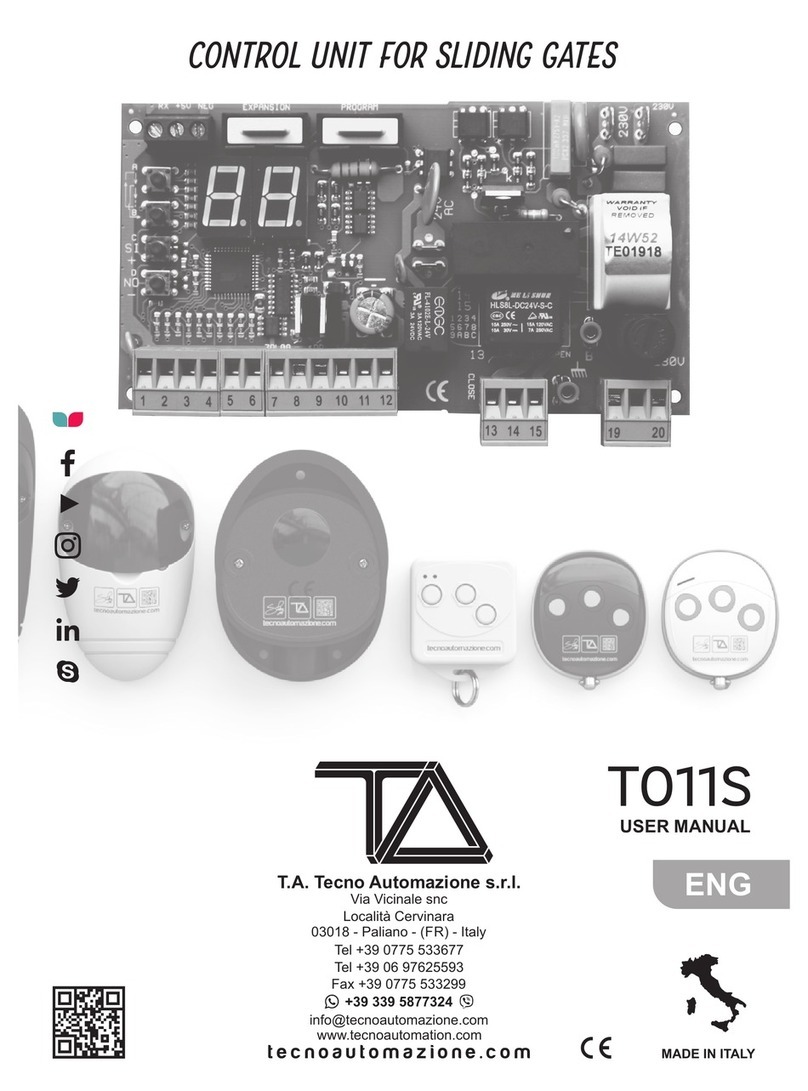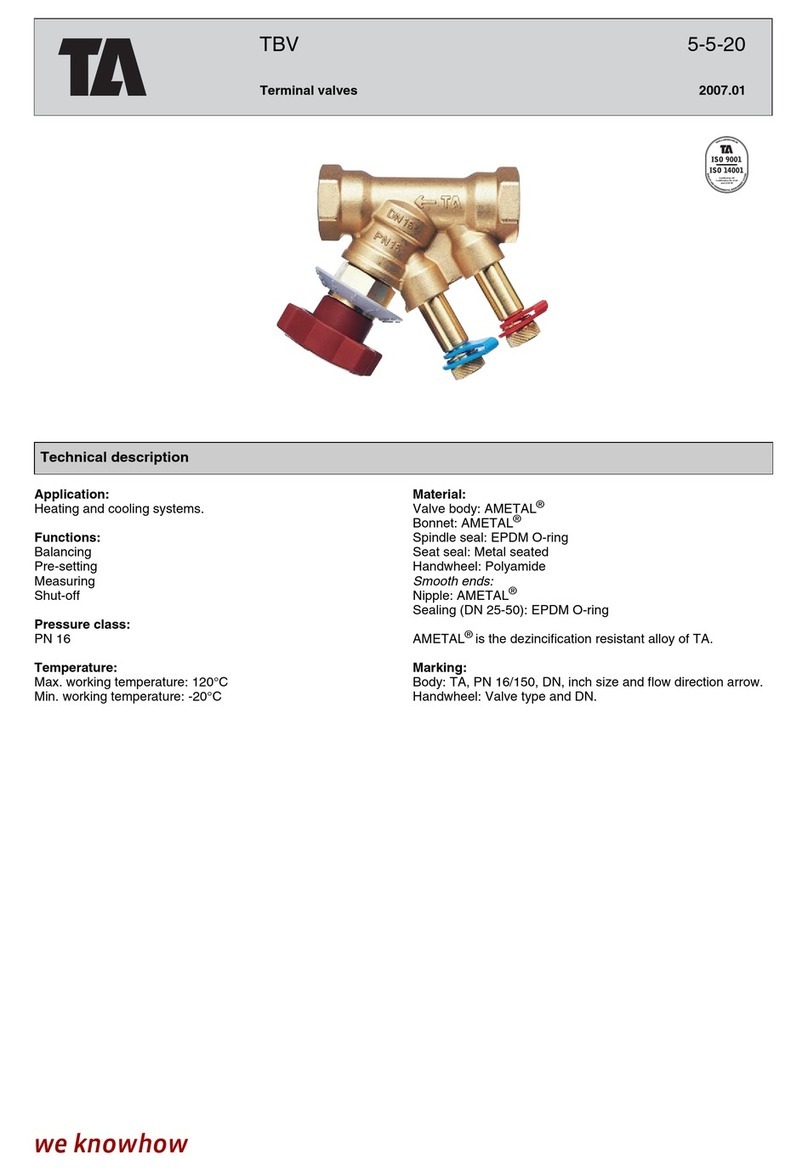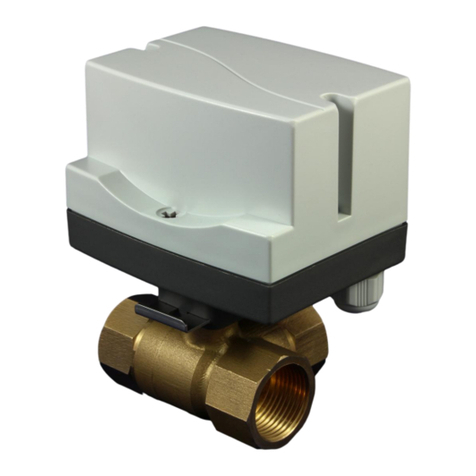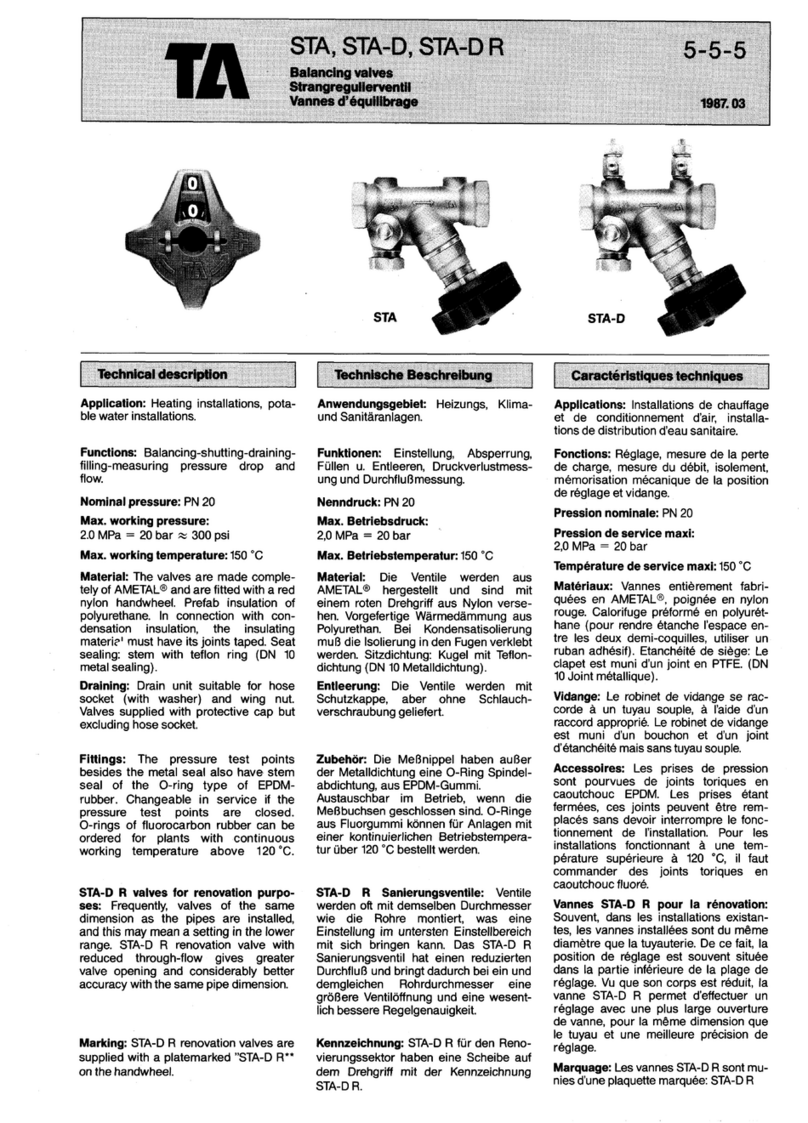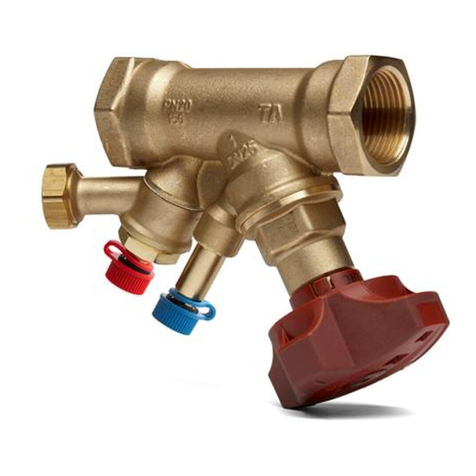
10
Regulation of water flow
The actual pressure drops in water
distribution pipework are difficult to
calculate accurately. This means that in
practice the flow rate, and consequently
the power distribution, is often incorrect.
With the balancing valve, however, it is
easy to set the desired flow rate.
Preparations for measuring
Valve
Open the valve to the desired setting.
Meter
Use electronic differential pressure ga-
uge CBI. The CBI is pre-programmed
with the duty curves for TA valves
STAD, STADA, STA-DR, STAF, STAF-
SG, STAF-R and for older STA-T so
that the registered differential pressure
can be read directly as flow rate.
More information about the CBI is found
under section 7.
Adjustment - working procedure
The procedure is more fully described in
the Balancing Handbook. The text
below is a brief summary. Preset all
valves in accordance with the
characteristic curve (set radiator valves
for ∆p = 8-10·kPa). Make sure that all
twoway balancing valves and radiator/
thermostatic valves are open. Reduce
the temperature so that selfacting
valves are open.
The TA method involves selecting the
valve at the far end of each circuit as
the reference valve. Use the main valve
for the circuit to maintain a constant
differential pressure (e.g. 3 kPa) across
the reference valve at the correct flow
rate. While maintaining these
conditions, adjust the other valves in the
circuit for correct flow through them,
starting from the valve that is next
furthest away, and work back towards
the pump.
When all the risers have been adjusted,
adjust the headers in the same way.
When the entire system has been
adjusted, all valves will have the correct
flow rate and all set values are locked
and recorded.
If it has been necessary to shut off the
valve before the pump, the pump can/
should be adjusted or replaced with one
of the correct capacity.
Einregulierung der
Durchflußmengen
Die tatsächlichen Druckverluste in den
verschiedenen Steigsträngen und
Gruppen eines Heizungssystems sind
schwer festzustellen. In der Praxis sind
oft die Wassermengen und dadurch
auch die Wärmemengen abweichend
von den theoretischen Berechnungen.
Mit den Mengenabgleichventilen
werden die gewünschten Durchfluß-
mengen einfach einreguliert.
Vorbereitungen für die
Druckverlustmessung
Ventil
Das Ventil auf die gewünschte
Einstellung öffnen.
Meßgerät
Elektronisches Differenzdruckmeßgerät
CBI verwenden. CBI ist mit den
Leistungskurven für die TA-Ventile
STAD, STADA, STA-DR, STAF, STAF-
SG, STAF-R und für ältere STA-T
vorprogrammiert, so daß man den
gemessenen Differenzdruck direkt als
Durchfluß ablesen kann.
Weitere Informationen über CBI unter
Register 7 (Katalogblatt 7-5-5).
Einregulierung - Arbeitsablauf
Im Handbuch "Einregulierung Total"
wird der Arbeitsablauf ausführlich
beschrieben. Nachstehend folgt eine
kurze Zusammenfassung.
Alle Ventile nach Auslegungsdaten
(Radiatorventile ∆p = 8-10 kPa)
einstellen. Zweiwege-Regelventile und
Radiator/Thermostatventile müssen
geöffnet sein. Die Temperatur senken,
damit selbstwirkende Ventile öffnen.
Bei der TA-Methode dient das in jedem
Kreis am weitesten entfernt
angeordnete Ventil als Referenzventil.
Mit Hilfe des Hauptventils für den
gesamten Kreis hält man den
Differenzdruck (z.B. 3,0 kPa) bei
berechnetem Durchfluß über dem
Referenzventil konstant. Unter
Beibehaltung dieses Wertes, wird bei
den übrigen Ventilen in diesem Kreis
nacheinander die gewünschte
Durchflußmenge eingestellt. Man
beginnt mit dem von der Pumpe am
weitesten entfernten Ventil. Wenn alle
Stränge fertig einreguliert sind, wird die
Hauptleitung auf die gleiche Art
einreguliert. Nach Einregulierung der
Anlage haben sämtliche Ventile den
richtigen Durchfluß, und alle
eingestellten Werte sind gesichert und
protokolliert.
Wenn es erforderlich war, ein Ventil vor
der Pumpe zu drosseln, sollte diese
richtig eingestellt oder durch eine
Pumpe mit der richtigen Förderleistung
ersetzt werden.
Réglage d'un débit d'eau
Il est difficile d'établir, par le calcul, les
pertes de charge réelles dans une
installation. De ce fait, les débits et, par
conséquent, la répartition calorifique,
sont souvent incorrects. Par contre, il
est très facile de régler le débit souhaité
avec une vanne d’équilibrage.
Préparatifs pour mesurer une
pression différentielle
Vanne
Ouvrir la vanne à la position de réglage
souhaitée.
Appareil de mesure
Utiliser le manomètre différentiel à
microprocesseur CBI, de TA. Le
microprocesseur incorporé dans
l'instrument contient, dans son
programme, toutes les courbes débit/
pression différentielle des vannes
d'équilibrage TA, pour leurs diverses
positions. (Consulter la documentation
technique CBI).
Méthode d'équilibrage
Voici un extrait résumé du manuel
"L'équilibrage hydraulique dans la
construction". Commencer par les
robinets de radiateurs: Régler la valeur
du Kv de ceux-ci pour un ∆P de 800
mmCE. Veiller à ce que les vannes de
régulation à deux voies et les robinets
thermostatiques soient bien ouverts.
Abaisser la température de l'eau de
sorte que les vannes automatiques
s'ouvrent. Pour que le ∆P appliqué à
chaque radiateur soit vraiment de
800mmCE, utiliser les vannes
d'équilibrage TA. Choisir la vanne de la
colonne la plus éloignée et la prendre
comme référence. Prérégler cette
vanne pour que le débit souhaité soit
obtenu pour une perte de charge de par
exemple 3 kPa (300 mmCE). Régler
ensuite les débits de chaque vanne,
dans l'ordre, en remontant en amont de
la vanne de référence. En agissant sur
la vanne de la distribution principale,
maintenir le ∆P de 300 mmCE à la
vanne de référence. Terminer par les
vannes de décharge BPV: Si le ∆P
choisi sur les radiateurs est de 800
mmCE, régler la BPV sur 900 mmCE,
soit 100 mmCE de plus. La BPV assure
la stabilisation de la pression différentie-
lle appliquée aux radiateurs et garantit
la constance du débit total de chaque
branche. Cette méthode d'équilibrage
permet de reprendre toute la pression
excédentaire dans la vanne principale.
A la fin de l'équilibrage on pourra
adapter la pompe exactement au circuit.
Demandez auprès de votre agent TA le
plus proche un exemplaire de notre
brochure "Les critères de qualité d´un
bon équilibrage hydraulique".












